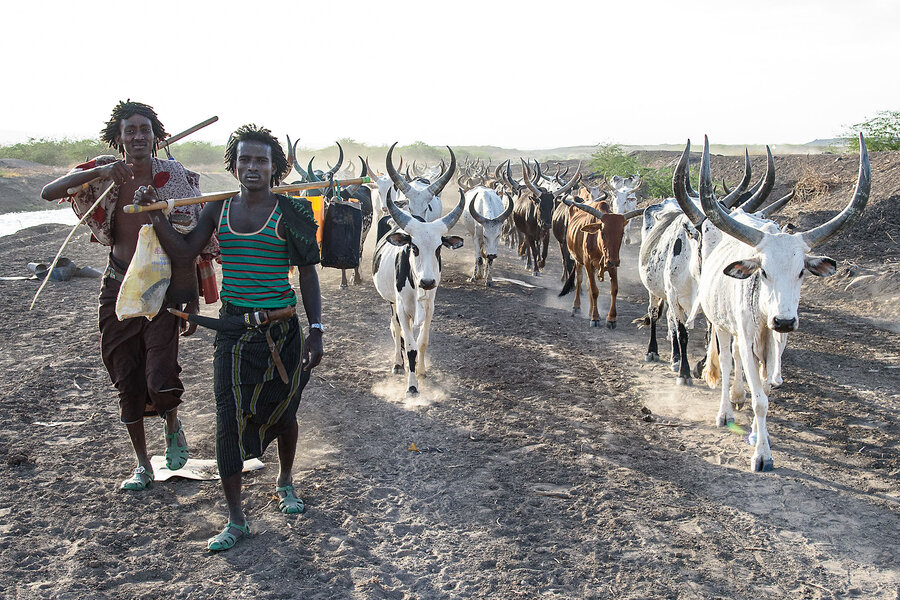World
Are world’s 200 million pastoral herders a climate threat?

In early 2020, just before the world locked down, I was in Ethiopia as a journalist, documenting the challenges faced by a tribe of nomadic pastoralists that has made its home in the Danakil Desert for over 1,000 years.
About 1.5 million Afar tribespeople migrate across an area larger than Ireland with their camels, cattle, sheep, and goats to wherever grass happens to be growing at any given time. They increasingly face persistent drought and rising temperatures.
Why We Wrote This
A story focused on
A U.N. report suggests that pastoralism may be part of the global emissions problem. Some researchers see the climate math on herders differently. The debate could affect nomadic and pastoral cultures worldwide.
Today, their way of life is also coming under pressure in some quarters as a contributor to the global climate crisis, due to the methane emissions of their herds compared with newer livestock methods.
Some scientists, however, say there’s no environmental reason to turn away from pastoralism. “Pastoralism is basically a fossil-fuel-free, totally solar-powered production system,” said Ilse Köhler-Rollefson, a co-founder of the League for Pastoral Peoples.
Thinking back to my experiences in Ethiopia, I recall what one Afar woman told me after walking for 10 days with her cattle and donkeys in search of pasture. “I never dream of moving to town.”
In early 2020, just before the world locked down, I was in Ethiopia as a journalist, documenting the challenges faced by a tribe of nomadic pastoralists that has made its home in the Danakil Desert for over 1,000 years. About 1.5 million Afar tribespeople migrate across an area larger than Ireland – and often called the hottest and driest place on Earth – with their camels, cattle, sheep, and goats to wherever grass happens to be growing at any given time.
I found some of the threats to their way of life to be region-specific, such as armed conflict with an aggressive neighboring tribe and locust plagues that decimated their already scant rangelands. But some of their other, even more intractable problems are shared by the estimated 200 million pastoralists around the world – the persistent drought, rising temperatures, and unpredictable weather patterns that scientists say are hallmarks of climate change.
“Life used to be good here. There was once so much grass, and it grew so high, that hyenas could hide in it and we couldn’t see them,” remembered Doge More, an Afar man in his 50s who didn’t know his exact age. “Now, there is no rain, so there are no grasses. We can’t keep cows anymore, and most people have very few animals at all. So what do we eat?”
Why We Wrote This
A story focused on
A U.N. report suggests that pastoralism may be part of the global emissions problem. Some researchers see the climate math on herders differently. The debate could affect nomadic and pastoral cultures worldwide.
Today, their way of life is under threat not only from changing conditions on the ground. Pastoralist communities are also coming under pressure in some quarters as a contributor to the global climate crisis. A December 2023 report by the United Nations Food and Agriculture Organization, for example, seeks to provide “a comprehensive assessment of greenhouse gas (GHG) emissions from livestock agrifood systems.” Some researchers say the report, in effect, suggests that pastoralism is part of the emissions problem.
That idea may sound hard to imagine. Like other pastoralist communities I’d written about and photographed over the years – all of whom are experiencing impacts of climate change firsthand – the Afar rely little on fossil fuels. They eschew consumer culture – partly due to poverty, partly because everything they own, including their huts, must be portable.
But when researchers calculate the amount of greenhouse gasses generated by a livestock system, most compare the amount of methane and carbon dioxide that’s emitted to the amount of protein that’s produced. By that measure, animals raised by traditional pastoralists are less efficient than those raised with newer, more intensive methods, the report says.
This is partly because indigenous breeds of livestock, well suited to their often harsh environments, are less productive than so-called improved breeds that are raised on farms. Additionally, a diet of wild grasses causes livestock to create more methane than if they eat formulated feeds.
The FAO report stops short of condemning pastoralism outright. It notes that pastoralist emissions make up only a fraction of the world’s total methane output. And it recognizes that moving away from traditional grazing may be “unfeasible” for the world’s poorest countries due to “nutritional challenges and … financial constraints.” But the report’s recommendations point away from pastoralism.
Is that pragmatism or a flawed narrative, like others that have pushed Indigenous and pastoralist peoples off their traditional lands?
The future of pastoralism may hinge on the answer. Climate policy experts widely agree that major changes are needed in agriculture, and notably the raising of livestock, to help tame the rise of heat-trapping gasses in Earth’s atmosphere. If policymakers believe traditional herds stand in the way of hitting methane targets, pastoralists may be pressured to stop herding. Age-old cultures could disappear, along with food systems that make resourceful use of marginal lands where crops won’t grow.
Already, for example, a 2021 policy brief by The Lancet has recommended that India, home to some 13 million to 20 million pastoralists, “needs to move away from the traditional animal husbandry practices” in order to reduce greenhouse gas emissions.
Some scientists, however, say there’s no environmental reason to turn away from pastoralism. The data behind the FAO report, and others like it, answers the wrong question, says ecologist Pablo Manzano, a fellow and rangeland expert at Spain’s Basque Centre for Climate Change.
Rather than looking only at methane levels produced by pastoralist herds, researchers should focus instead on how those compare with the emissions that would be produced by the same ecosystems if herds were absent, Dr. Manzano says.
“Many of those emissions are going to happen, whether or not livestock is there,” he says.
Should pastoralist herds be removed from their landscapes, the void that they leave would likely be filled by other herbivores, he argues, which would produce similar amounts of methane.
Additionally, responsible grazing keeps grasslands healthy, increasing biodiversity and providing a natural carbon sink, while reducing the risk of wildfires, Dr. Manzano says.
In an email response, FAO says it focuses on estimating methane emissions “from all livestock systems, including pastoral systems.” That approach leaves out the additional factors raised by Dr. Manzano.
Questions regarding pastoralism are just one piece of the larger puzzle about how human land use and food production should evolve to address climate change. But to those who live within pastoralist societies, the implications are particularly large.
“Pastoralism is basically a fossil-fuel-free, totally solar-powered production system that does not require feed inputs, fertilizers, or pesticides,” said Ilse Köhler-Rollefson, a veterinarian who has lived closely with the Raika tribe in Rajasthan, India, since 1990, and who is a co-founder of the League for Pastoral Peoples. “But it is under pressure worldwide, and has in many places already become extinct.”
Thinking back to my experiences in Ethiopia, I recall what one Afar woman told me, which echoed the sentiments of many of the pastoralists I’ve spent time with over the years. “Our life depends on animals. It’s all we know,” said Hasina Wegris Al-Mohammed, who had just walked for 10 days across the desert with her cattle and donkeys in search of pasture. Despite the hardships of her nomadic life, she expressed no interest in trading it for a settled one. “I never dream of moving to town,” she said.









